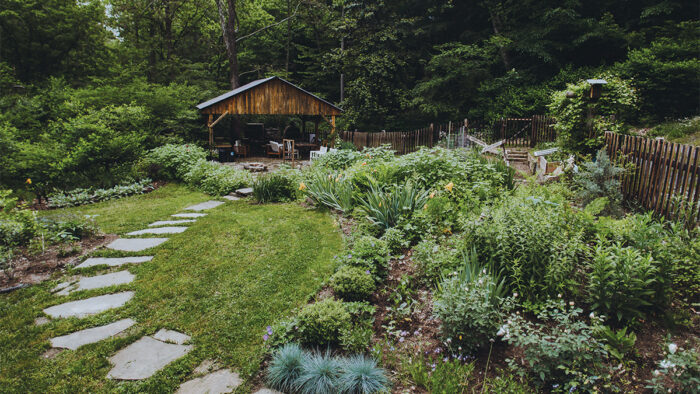
When Lindsey Cline and Corey Shrader purchased their 9-acre property in the Blue Ridge Mountains of Virginia, it would be an understatement to say that there was a lot of work to be done. The cabin had been taken apart, and the backyard had been overrun by invasives such as Japanese stiltgrass (Microstegium vimineum). But the couple wasted no time digging in to clear out the offenders, which made way for native plants such as Jack-in-the-pulpit (Arisaema triphyllum, Zones 4–9) and jewelweed (Impatiens capensis, annual) to emerge. While these plants flourished, some of Lindsey’s first planted efforts were floundering. Azaleas, hydrangeas, and hostas were no match for the soggy soil or the large herd of deer that were endemic to the area.
Garden at a glanceSize: 9 acres total, 1 acre landscaped Location: Amherst, Virginia Zone: 7 Conditions: Partial to full shade; wet to moist soil Age of the garden: Nearly 10 years |
But early failures were not enough to deter Lindsey. As she explains, “I wanted gardens that were striking but also appropriate for a log cabin and forest setting.” And she was able to find the right inspiration from Piet Oudolf, Tom Stuart-Smith, Roy Diblik, Austin Eischeid, and Adam Woodruff—all experts in naturalistic designs. “Whether you call their style a matrix planting, sustainable landscape, or something else entirely, I wanted its features—overflowing beds, layered drifts, and striking color and texture combinations,” Lindsey says. Once she knew the style she wanted, the challenge became translating those designs to the couple’s wooded, mountain property.
“Eventually I found species that thrived in our conditions, which I planted in connecting drifts,” she says. “I layered bold textures next to finer ones and let the contrast provide focal points in the shady areas.” Solomon’s seal (Polygonatum spp. and cvs., Zones 3–9), Canadian wild ginger (Asarum canadense, Zones 2–8), a variety of sedges (Carex spp. and cvs., Zones 3–9), and woodland phlox (Phlox divaricata, Zones 3–8) are some of the spring stars. These are followed through summer by mountain mint (Pycnanthemum muticum, Zones 4–8), a variety of ferns, bee balm (Monarda spp. and cvs., Zones 4–9), and yarrow (Achillea millefolium, Zones 4–8). Lindsey thinks fall might be the real peak of the garden, with lots of woodland sunflower (Helianthus divaricatus, Zones 3–8) and blue mistflower (Conoclinium coelestinum, Zones 5–10), and with scores of asters (Eurybia divaricata and Symphyotrichum novae-angliae, Zones 4–8) on display.

Small vignettes were built so the pair could sit and enjoy the spaces they created. A grape arbor, hammock, pavilion, and two firepits were cozy additions that were welcoming but didn’t overpower the small house or landscape. In fact, their work on the property was so rewarding that it inspired them to start a small naturalistic landscape design-build company in Virginia. Now Corey’s skills as a stonemason and Lindsey’s eye for natural garden design help pay the bills. And what about the project that started it all? Lindsay says the cabin and its gardens have become a favorite spot to gather with friends: “We say it invites you to kick off your shoes and sip your favorite whiskey!”

Kaitlyn Hayes is the digital content manager for Fine Gardening.
Photos, except where noted: Amber Mae Photography, courtesy of Lindsey Cline
Check out these other awesome reader-submitted gardens:
- A Garden That Shines in Spring
- Turning a Large Property into a Multifaceted Garden
- A Woodland Garden That Takes Inspiration from Nature
Have a garden you’d like to share?
Have photos to share? We’d love to see your garden, a particular collection of plants you love, or a wonderful garden you had the chance to visit!
To submit, send 5-10 photos to [email protected] along with some information about the plants in the pictures and where you took the photos. We’d love to hear where you are located, how long you’ve been gardening, successes you are proud of, failures you learned from, hopes for the future, favorite plants, or funny stories from your garden.
If you want to send photos in separate emails to the GPOD email box that is just fine.
Have a mobile phone? Tag your photos on Facebook, Instagram or Twitter with #FineGardening!
You don’t have to be a professional garden photographer – check out our garden photography tips!
Do you receive the GPOD by email yet? Sign up here.




















Comments
Log in or create an account to post a comment.
Sign up Log in